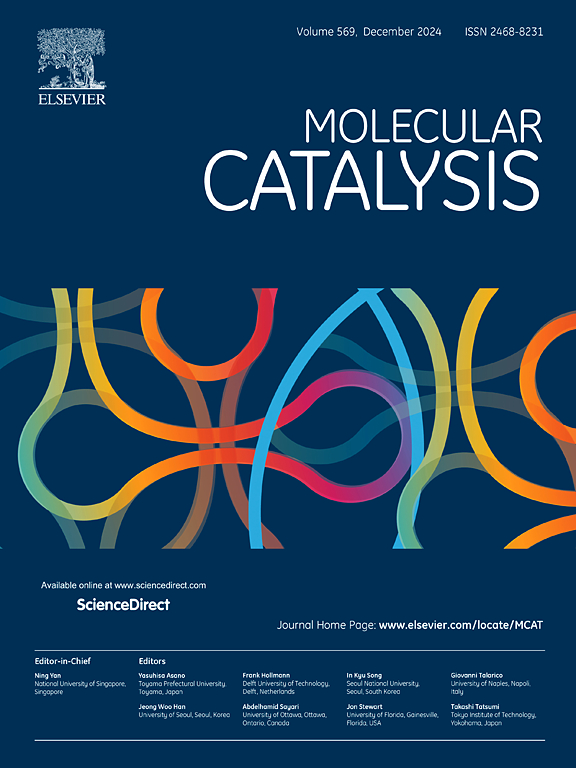Kinetic study of the double dehydration of sorbitol into isosorbide over commercial sulfonic acid resin
IF 3.9
2区 化学
Q2 CHEMISTRY, PHYSICAL
引用次数: 0
Abstract
Biomass-derived chemicals show great promise as an alternative resource for the replacement of fossil fuel-derived chemicals. The double dehydration of sorbitol produces isosorbide, which is an important chemical building platform and a component in food, pharmaceuticals, and plasticizers. Homogeneous catalysts are used to perform this reaction due to their good performance, but they also exhibit some drawbacks. Therefore, in this study, the sulfonic acid resin Purolite CT269 was used as a heterogeneous catalyst to study isosorbide production. The reaction was carried out with a 4.43 wt.% catalyst loading, reaction temperature of 151 °C, and reaction time of 4 h under a vacuum. 100 % conversion of sorbitol was observed within 2 h, and an isosorbide yield of about 78 % was achieved after 4 h. The kinetics of the reaction were evaluated, the rate law followed a first-order reaction model, and the reaction rate depended on the concentration of reactant. The Langmuir–Hinshelwood–Hougen–Watson (LHHW) model was used to determine that the first dehydration was the rate-determining step of this reaction. The study also examined the deactivation of the catalyst using FE-SEM, N2 adsorption/desorption, DSC, TGA, and XPS, confirming that changes to the catalytic properties after the reaction negatively impacted the performance of the sorbitol dehydration reaction. The catalytic performance and kinetic analysis were used to explain the mechanism of the double dehydration of sorbitol into isosorbide, providing essential information for catalyst and isosorbide production process design.

在商用磺酸树脂上将山梨醇双脱水成异山梨醇的动力学研究
生物质衍生化学品作为替代化石燃料衍生化学品的一种替代资源,前景十分广阔。山梨醇的双重脱水生成异山梨醇苷,这是一种重要的化学构建平台,也是食品、药品和增塑剂中的一种成分。均相催化剂因其良好的性能被用于进行该反应,但它们也表现出一些缺点。因此,本研究使用磺酸树脂 Purolite CT269 作为异相催化剂来研究异山梨醇的生产。反应在真空条件下进行,催化剂负载量为 4.43 wt.%,反应温度为 151 °C,反应时间为 4 小时。对反应动力学进行了评估,发现其速率规律遵循一阶反应模型,反应速率取决于反应物的浓度。利用 Langmuir-Hinshelwood-Hougen-Watson (LHHW) 模型确定了第一次脱水是该反应的速率决定步骤。研究还使用 FE-SEM、N2 吸附/解吸、DSC、TGA 和 XPS 等方法检测了催化剂的失活情况,证实反应后催化特性的变化对山梨醇脱水反应的性能产生了负面影响。利用催化性能和动力学分析解释了山梨醇双脱水成异山梨醇苷的机理,为催化剂和异山梨醇苷生产工艺设计提供了重要信息。
本文章由计算机程序翻译,如有差异,请以英文原文为准。
求助全文
约1分钟内获得全文
求助全文
来源期刊

Molecular Catalysis
Chemical Engineering-Process Chemistry and Technology
CiteScore
6.90
自引率
10.90%
发文量
700
审稿时长
40 days
期刊介绍:
Molecular Catalysis publishes full papers that are original, rigorous, and scholarly contributions examining the molecular and atomic aspects of catalytic activation and reaction mechanisms. The fields covered are:
Heterogeneous catalysis including immobilized molecular catalysts
Homogeneous catalysis including organocatalysis, organometallic catalysis and biocatalysis
Photo- and electrochemistry
Theoretical aspects of catalysis analyzed by computational methods
 求助内容:
求助内容: 应助结果提醒方式:
应助结果提醒方式:


